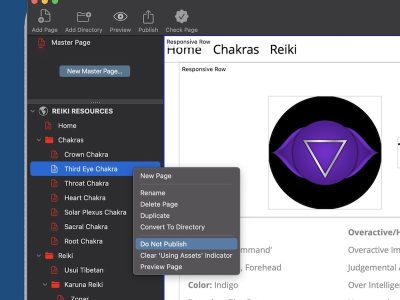If you’re new to EverWeb, you’re probably keen to start building your website straight away. However, it’s worth taking a breath before jumping in so you can set up your EverWeb environment properly before getting down to work on your website. Start by launching EverWeb and creating a new website project, or if you have already started your project, double click on it’s name in the Projects Window to open it.
Log In To Your EverWeb Account
Start by checking that you are logged in to your EverWeb Account using the EverWeb-> Preferences menu. The first tab is ‘Account’. Enter your account details if it’s not already pre-filled, or if you have not done so already, create an account. Logging in to your EverWeb account is important as it’s how EverWeb determines whether you have a purchased or demo version of the product. The only difference between purchased and demo is the ability to publish your website is disabled for the demo version.
Auto Save and Automatic Backup
Once logged in to your EverWeb account I recommend that you immediately set Autosave and Automatic Backup on. These features are also in the EverWeb-> Preferences menu on the ‘Backup’ tab. Autosave and Backup are invaluable tools that can save you lots of time, effort and frustration if you ever have problems with a Project file and need to ‘rollback’.
‘Autosave’ saves your work on the fly and ‘Backup’ creates a back up copy of your Project file in the location you choose on a daily, weekly or monthly basis. You keep from one to 50 backups at any one time. This is useful if, for example, you’ve made changes to your website that you want to reverse out. You may need to go back a couple of backup copies to reverse out all the changes you don’t want.
When you use ‘Backup’ remember that if you delete your Project file, the backups are also deleted.
It’s also a good idea to backup your computer regularly using tools such as Apple’s Time Machine or a third party backup solution. In this way you have less risk of losing any valuable work.
Name Your Website
When setting up your Project file you’ll want to name it! It’s often a question on the EverWeb Discussion Forum, but easy to answer when you know how! By default, all new websites you create are called ‘NEW WEBSITE’. Double click on this text in the Web Page List that runs down the left side of the Project Window. Enter the name you want as the website Project and press Enter to finish.
Set Default Styles
When you start a new website Project you’ll hopefully know what fonts and color palette your website will be using. Set these choices up as defaults for the Project using the Format-> Default Styles menu to access the list of styling attributes that you can change. Click on the ‘Save’ button when finished. Note that ‘Default Styles’ are not applied retrospectively. If, for example, you have changed the ‘Body Text Font’ default, this change is only effective when creating new Text Boxes. For any existing Text Boxes, you will need to change the font manually.
Publishing Settings
There will come a time when you’ll want to publish your website! It’s worth setting up your Site Publishing Settings at the start of your project so when you are finished, or want to test, everything is already in place.
Access the Site Publishing Settings either by the File-> Edit Publishing Settings menu or by double clicking on your website name in the Web Page List. There are three ‘Publish To’ options on the drop down menu. Select ‘EverWeb’ if you have an EverWeb+Hosting plan and ‘FTP Server’ if you have your own hosting provider. Fill in the details as required. If you are using FTP Server and are not sure about the details to fill in, your host provider should be able to help. You can also checkout this video on Publishing in EverWeb. This video walk through is a couple of years old so the EverWeb UI may look a bit different to your version of EverWeb, but the principles remain the same.
The third Publish To option is ‘Folder’ which is useful for testing your website locally before publishing to the Internet.
Email. 404 Page Not Found and Favicon Setup
The Site Publishing Settings is also where you can add email addresses to your website if you have an EverWeb+Hosting plan. For help, click on the ‘?’ to the right of the ‘Email Addresses’ heading. If you have your own host provider use your host provider’s cPanel to setup your email addresses.
At the end of the Head/Footer Code section, is a section where you can select an image to use as a Favicon for your website.Checkout our article on Favicons for more information!
In the ‘Advanced Options’ section of the Site Publishing Section you can also set up a link to a ‘404 Page Not Found’ to capture instances where there may be broken links in your website. It’s a great safety net and we’ll feature this more in an upcoming blog.
Other EverWeb Preferences
The other settings that you will probably want set are the General Preferences in the EverWeb-> Preferences menu. Here you can set the guides that you see when moving objects around the page and whether you want to see the Hyperlink Indicator when you set up Hyperlinks in your web pages.
Spell checking is a great option to set up when you create your website so you don’t get misspellings on your pages! Use the Edit-> Spelling menu and tick the option you want to use. I usually recommend ‘Check Spelling While Typing’ is set on.
Finally, the Window menu can be used to set up whether the Layout is displayed or not and whether the Toolbar and Inspector Window are displayed or.
There may seem a lot that can be set up here, but with just a few minutes work, you’ll have the website project environment you want and you’ll be more efficient in process!
If you have a question about this post, please drop us a line in the Comments section below. Thanks!









Comments